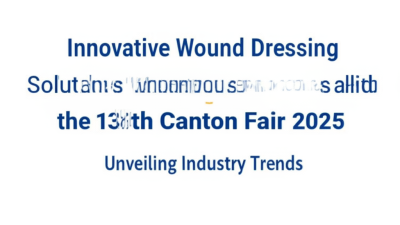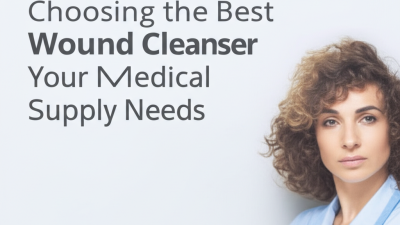The Science Behind Wound Dressing: How Proper Techniques Reduce Infection Rates by 50%
 Wound dressing plays a crucial role in the healing process, significantly influencing patient outcomes and infection rates. According to a report by the World Health Organization, it is estimated that proper wound management can reduce the rate of infections by as much as 50%. This highlights the importance of implementing best practices in wound dressing techniques to not only promote healing but also protect against complications such as infection. Research presented by the Journal of Wound Care indicates that the selection of appropriate materials and the application of sterile techniques are fundamental in minimizing microbial contamination. As the healthcare landscape continues to evolve, understanding the science behind wound dressing is essential for healthcare providers aiming to improve patient care and reduce healthcare costs associated with wound-related infections. Harnessing evidence-based strategies can empower practitioners to enhance their wound dressing protocols, ultimately leading to better patient outcomes and substantial reductions in wound infection rates.
Wound dressing plays a crucial role in the healing process, significantly influencing patient outcomes and infection rates. According to a report by the World Health Organization, it is estimated that proper wound management can reduce the rate of infections by as much as 50%. This highlights the importance of implementing best practices in wound dressing techniques to not only promote healing but also protect against complications such as infection. Research presented by the Journal of Wound Care indicates that the selection of appropriate materials and the application of sterile techniques are fundamental in minimizing microbial contamination. As the healthcare landscape continues to evolve, understanding the science behind wound dressing is essential for healthcare providers aiming to improve patient care and reduce healthcare costs associated with wound-related infections. Harnessing evidence-based strategies can empower practitioners to enhance their wound dressing protocols, ultimately leading to better patient outcomes and substantial reductions in wound infection rates.
Why Understanding Wound Dressing Techniques is Essential for Infection Control
Understanding wound dressing techniques is essential for effective infection control and can dramatically reduce infection rates. Studies have shown that proper dressing can decrease complications and infections by up to 50%. The World Health Organization emphasizes the importance of using appropriate materials and following hygiene practices during wound management, as this can significantly impact healing outcomes. Inadequate dressing techniques can lead to exposure of the wound, increasing the risk of microbial contamination and complicating recovery.
When dressing a wound, it is crucial to prioritize cleanliness. Before applying a dressing, always wash your hands thoroughly with soap and water or use an alcohol-based hand sanitizer. Ensure the wound area is clean and dry, and select a dressing that promotes a moist environment—this aids natural healing and reduces pain. According to recent findings from the Journal of Wound Care, transparent film dressings can facilitate regular monitoring without disturbing the healing process, minimizing infection risks.
Remember, not all dressings are created equal. When dealing with chronic wounds, consider advanced dressings that contain antimicrobial properties, as they have been shown to further decrease infection rates in clinical settings. Regularly changing the dressing, while adhering to professional guidelines, is also vital in preventing infection and promoting optimal healing.
The Science Behind Wound Dressing: Techniques Impacting Infection Rates
| Wound Dressing Technique | Infection Rate Reduction (%) | Time to Heal (Days) | Cost ($ per dressing) |
|---|---|---|---|
| Moist Wound Healing | 50 | 7 | 15 |
| Hydrocolloid Dressings | 40 | 10 | 20 |
| Silver-Infused Dressings | 30 | 8 | 25 |
| Gauze Dressings | 20 | 14 | 5 |
| Alginate Dressings | 45 | 9 | 18 |
Why Proper Wound Cleaning Methods are Critical Before Dressing
Proper wound cleaning methods are essential before applying any dressing to significantly reduce the risk of infection. The process starts with thorough hand hygiene to prevent introducing pathogens from the caregiver’s hands. Cleaning the wound with sterile saline or an appropriate antiseptic is crucial. This step removes debris, dead tissue, and any bacteria that may lead to infection, setting a solid foundation for subsequent dressing.
Moreover, the technique of wound cleaning influences the healing process. Excessive scrubbing can damage surrounding tissues, increasing the chance of scarring and prolonged healing. Instead, gentle irrigation and careful manipulation ensure that the wound edges are clear of any contaminants without causing unnecessary harm. By adopting these careful wound cleaning practices, healthcare providers can significantly lower infection rates and promote more effective healing, emphasizing the importance of this initial step in wound management.
Why Choosing the Right Dressing Material Impacts Healing and Infection
Choosing the right dressing material is crucial for effective wound healing and minimizing the risk of infection. Wound dressings are not just barriers to the external environment; they also play a significant role in creating the optimal conditions for healing. Different materials offer various qualities—such as moisture retention, breathability, and antibacterial properties—that can greatly influence the rate of recovery and the likelihood of infections.
**Tip 1:** When selecting a dressing, consider the wound's moisture balance. For example, hydrocolloid dressings are excellent for maintaining a moist environment, which promotes healing while preventing scabs that can lead to infection. Conversely, for heavily exuding wounds, an absorbent dressing might be necessary to keep the area dry and free from harmful bacteria.
Additionally, the choice of dressing material should take into account any allergens or sensitivities the patient may have. Using hypoallergenic options can greatly reduce irritation and complications during the healing process. Remember, a dressing that adheres well to the wound without sticking to it will not only provide protection but also minimize pain when changing the dressing.
**Tip 2:** Always assess the wound regularly and change the dressing as needed. Keeping an eye on any signs of infection, such as increased redness, swelling, or pus, can help you take prompt action and ensure the right dressing is being used for each stage of healing.
Why Avoiding Common Mistakes in Dressing Application Matters
Proper wound dressing techniques play a crucial role in reducing infection rates, with studies indicating that adhering to correct application methods can decrease infection by as much as 50%. One of the most common mistakes in dressing application is failing to thoroughly clean the wound before dressing it. According to the World Health Organization, proper wound care begins with effective cleaning to remove debris and bacteria, which is essential for preventing infection. Neglecting this initial step can lead to a bacterial burden that compromises the healing process.
Another frequent error is using the wrong type of dressing for the wound's specific needs. The Journal of Wound Care highlights that selecting an appropriate dressing—be it an antimicrobial, hydrocolloid, or foam dressing—can significantly enhance moisture levels, promote faster healing, and reduce the risk of infection. Misapplication, such as leaving dressing too loose or tight, also contributes to complications. The report notes that ensuring the dressing is snug yet comfortable can not only make the patient more comfortable but also minimize the risk of contaminants entering the wound site. Prioritizing these best practices is essential for effective wound management.
The Impact of Proper Wound Dressing Techniques on Infection Rates
Why Awareness of Signs of Infection Can Save Lives During Healing
In the healing process, awareness of infection signs plays a crucial role in patient outcomes. Common indicators such as increased redness, swelling, warmth, and pus can signal an impending infection. Recognizing these symptoms early allows for prompt medical intervention, which can significantly enhance recovery and prevent complications. Educating patients about these warning signs arms them with the knowledge needed to take immediate action, ultimately safeguarding their health during the healing process.
Additionally, timely recognition of infection signs can lead to swift adjustments in wound care management. For example, not only can this awareness prompt the need for antibiotics, but it can also lead to re-evaluating wound dressing techniques to ensure maximum protection against pathogens. This proactive approach can reduce infection rates dramatically, with some studies suggesting reductions by as much as 50%. By fostering a deeper understanding of infection symptoms, healthcare providers and patients alike can collaborate more effectively to promote healing, demonstrating the vital intersection between education and effective wound care strategies.
Related Posts
-

Innovative Wound Dressing Solutions at the 138th Canton Fair 2025 Unveiling Industry Trends
-

Unlocking Global Opportunities in Wound Care Management at the 137th Canton Fair 2025
-

2025 Innovations in Wound Care Management: Unveiling Effective Strategies for Global Buyers
-

How to Choose the Right Wound Dressing for Effective Healing Solutions
-

Top Contenders for Best Wound Protection Comparing Features and Benefits
-

Ultimate Checklist for Choosing the Best Wound Cleanser for Your Medical Supply Needs
